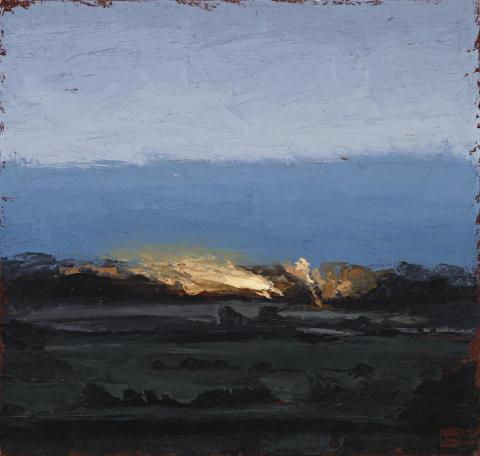IDYLL XIV, 2005
PHILIP WOLFHAGEN
oil and beeswax on linen
96.5 x 101.5 cm
signed with monogram, dated and titled lower right: W MAY / 2005 / Idyll XIV
inscribed verso: PHILIP WOLFHAGEN / Idyll XIV / ...
Christine Abrahams Gallery, Melbourne (label attached verso)
Private collection, Sydney
Night Beacons, Christine Abrahams Gallery, Melbourne, 2005
For Philip Wolfhagen the intersection of language and art is an important and interesting space. Towards the completion of each body of work he carefully considers the title for each work, and the series as a whole. Wolfhagen describes this process of naming and its relevance as, 'It is all about perception with my paintings and I am always very careful about titles. Getting the right title for a body of work is as exhilarating to me as the painting. That use of language to set people on the right track to understand what I am trying to say is paramount.'1
An idyll within the conventions of literature is a short descriptive poem, the most well known being Theocritus' Idylls which describe scenes of pastoral life in ancient Greece. Through his careful selection of title, Wolfhagen elevates this landscape above the descriptive. It is not necessarily a specific location but rather the idea of that landscape, mapped out in oil and beeswax applied with broad gestural sweeps. The brevity of his handling of the medium itself can also be interpreted as conforming to the structure of an idyll, a landscape and story told through only a few marks and gestures.
Here in this space a fire burns in the middle distance, blown forcefully across the picture plane by the oceanic winds of Tasmania. Exhibited as part of a body of work collectively known as 'Night Beacons', Idyll XIV is a landscape of cusp of darkness. The skies diffuse with the remnants of sunlight, the beacon or signal-fire burns at the horizon beckoning us into the night.
1. Speed, A., 'Tasmanian artist Philip Wolfhagen is a true natural', The Australian, 15 October 2011
MERRYN SCHRIEVER
